
Aside from being a unique and naturally-rich country, Australia not only boasts beautiful pristine beaches, diverse wildlife, and the amazing outback. It is also home to some of the most prized, rare and elegant gemstones in the world.
Diamonds
A beguiling, elegant and expensive byproduct of the most common element found on earth – carbon – diamonds are one of the most much-coveted jewels on Earth,
never ceasing to captivate and mystify people since the dawn of time.
Diamonds are crystallised pure carbon and come in a different range of colours such as brown, yellow, blue, purple, red and pink, as a result of the inclusion of minerals throughout their natural development stages, spanning millions of years.
The distinctive properties - optical and physical - of diamonds are reputedly the most lustrous among transparent gemstones taken from the Greek word Adamas or “invincible” given the stone’s hardness which is rated 10 on the Mohs scale.
Australia has been one of the foremost sources of diamonds worldwide, producing some of the finest and rarest colour diamond pieces in the jewellery world.
Diamond production in Australia traces back to Bathurst, New South Wales in 1851. Mining took off in 1867 which produced large quantities of diamonds in the Copeton and Bingara alluvial deposits until 1922.
From there small-scale, low-profile diamond production and explorations continued throughout Australia.
During the mid-1970s, geologists discovered 23 low-grade diamondiferous pipes in Ellendale in Western Australia. That was followed by the discovery of alluvial deposits at Kimberley’s Argyle in 1979 which would become the world’s richest diamond deposit.
The Argyle mine was the largest diamond producer in terms of volume, and supplied a third of the world’s diamonds annually, and produced some of the rarest stones with the highest diamond grades.
Beginning in the late 1980s, Rio Tinto – which operated Argyle – supplied more than 90 per cent of the world’s pink diamonds, until it mining operations ceased in November 2020 after producing more than 865 million carats throughout its 37 years of operation.
Diamond mining operations are expected to be revived by the end of 2022 at the mothballed Ellendale mine. The Merlin mine is targeted to resume operations in 2023.
Here are some of the most notable diamonds from Australia;
> A highly-sought 104.73-carat rough exquisite white diamond was discovered in the Merlin mine in 2002 and is reputed to be one of the largest diamonds found in Australia.
> Another rare piece is a 35.26-carat rough brown diamond also unearthed from the Merlin mine in 2017, which is considered to be the fifth-largest diamond recorded from the continent.
> The Argyle Octavia is a 28.84-carat white diamond discovered in 2019. It is one of the largest white diamonds to come from the Argyle mine.
> The largest pink diamond in Australia is the 12.8-carat light pink diamond, known as the Argyle Jubilee, which was unearthed in 2012. It was cut and polished down to an 8.01-carat gem and is currently on display at the Melbourne Museum.
> Another one on the list of Australia’s largest gemstones is an 8.43-carat fancy yellow diamond discovered in 2017 at the Blina project in Ellendale. The diamond was discovered two years after the mine was officially closed as explorations continued.
Sapphires
A member of the corundum family, Sapphires are allochromatic minerals, deriving their colour from chemical impurities in their crystal structure.
These impurities absorb specific parts of the light spectrum, and the remaining light reflected gives the gemstone its alluring colour.
Sapphires contain traces of titanium, iron, and nickel, which provides them with a range of colours including blue, orange, black, green, yellow and pink. The more iron the sapphire contains, the darker the colour.
The most common varieties are blue sapphires, and gems sporting a rich blue to violet colour are the most desirable pieces. Sapphires rank second to diamonds in terms of hardness, which is rated nine on the Mohs scale.
The term “sapphire” means blue corundum and when the gem is not blue, the colour adopted in the name for identification, with examples being the green sapphire, pink sapphire or yellow sapphire.
On the yellow to orange spectrum, colours range from strongly saturated golden yellows typical in Australia, to soft pastel tones seen in Ceylon sapphires.
Sapphires are often heat-treated to eliminate silk inclusions to enhance the richness and clarity of colour.
One distinctly home-grown pride of Australia is the colour-changing sapphire which comes from central Queensland and possesses unique and unusual properties. The gemstones change colour from yellow to pink, brown to green, or golden orange to orange-green.
Sapphires were first extracted in Australia in 1851 by gold miners on the Macquarie and Cudgegong rivers in New South Wales, with commercial mining beginning in 1919. Sapphire production in eastern Australia was limited until mechanised mining technology was introduced in the late 1950s.
By the 1980s, Australia became source of around 70 per cent of the world’s sapphires, which mostly came from New South Wales. As mechanised mining became more common and introduced in other countries, Australia’s share of the market dropped to around 20 to 30 per cent.
Sapphires are found in all eastern Australian states, including Tasmania. In New South Wales, sapphires were mined in the New England region around Glen Innes and Inverell, as well as the northwest of Goulburn, near Oberon. The Kings Plains area near Inverell has some of the richest gem-quality sapphire deposits.
Corundum has also been mined in central Queensland, as has Rubyvale, Anakie, the Willows, Glenalva and the aptly named Sapphire. Additionally, sapphires were recovered from rundown tin workings along Tasmania’s Weld River.
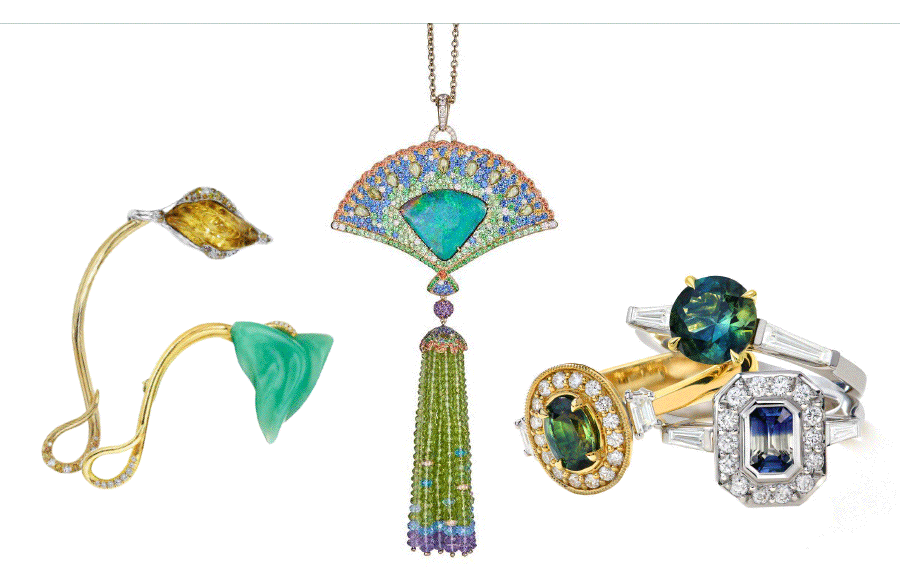
Left to Right: Naomi Sarna; Margot McKinney; Sapphire Dreams |
Opals
Opals are multi-coloured hydrated amorphous gemstones consisting of small silica spheres arranged in a regular pattern, with water naturally infused between the spheres.
The spheres diffract white light that breaks up into the different colours of the spectrum in a process called opalescence.
Larger spheres allow for many colours throughout their structure, while smaller ones contain only greens and blues.
Opals with predominantly red colours are very rare and are found in areas where larger silica spheres were deposited.
Opals are frequently layered and the presence of a rare red layer at the base in the thinnest portion of the vein indicates that gravity naturally contributed to the arrangement of the silica spheres over time.
White opals possess delicate, pale colours on a lighter background, while black opals are very rare and highly desired due to their dark background, with colours ranging from brilliant red through to greens, blues and purples.
Boulder opals are cut and polished with a natural host rock called ironstone on the backside.
Most precious opals are found in sandstones and mudstones that developed during the Cretaceous era. Sedimentary rocks that have been deeply weathered produce silica that is released into the groundwater. Small faults and joints in the rocks formed the pathways that drove groundwater further down the earth’s surface.
The strong interlocking barriers between the sandstone and rocks trap the silica-carrying groundwater which slowly hardens into a gel that forms opal veins and lenses.
To date, Australia is the only place on Earth where opalised animal and plant fossils are found. Small opalised dinosaurs and primitive mammalian remains were found at Lightning Ridge in New South Wales, along with prehistoric shallow marine shellfish and crustaceans.
Perhaps the most popular opalised fossil is that of Eric the Pliosaur – a Cretaceous marine vertebrate discovered in Coober Pedy and has become a prized collection at the Australian Museum. Not only was the opalised skeleton of the dinosaur fossil well-preserved, but its stomach contents, believed to be a final meal of fish, were also turned to opal.
Opalised fish bones and shelly molluscs are also fairly common at Coober Pedy, South Australia and are desired and valued according to their appearance and intensity of the play of colours.
Most opals are cream-coloured and lobe-shaped minerals resembling a pinecone or pineapple with a distinctive blue sheen.
Mineral replacement with opal can also occur, such as ‘opal pineapples’ found at White Cliffs, New South Wales which are opal pseudomorphs of the mineral ikaite.
South Sea pearls can only be cultured from the Pinctada maxima oyster species with meticulous care in pristine environmental conditions.
These oysters are found in the Indian and Pacific oceans off the coasts of Australia, Indonesia, Myanmar and the Philippines.
South Sea pearls have a thick nacre and distinctive lustre compared to the smaller Akoya pearls which are cultured in China, India and Japan. The classic white is the most desired of all colours in South Sea pearls, followed by pearls with rarer golden tones.
The oysters in which South Sea pearls are grown determine the specimen’s colour. The silver-lipped or white-lipped oyster variety that produces white pearls with a silvery overtone is found in the waters around northern Australia and southern Indonesia. Other notable and valuable colours include bluish and pinkish overtones.
The South Sea pearls are the largest among the cultured pearl varieties. The average South Sea pearl takes approximately four years to develop, which can take longer when producing larger pearls. Their size ranges from 8mm to 22mm, of which the larger specimens are rarer and more valuable.
Topaz
Another gemstone with a fascinatingly radiant optical phenomenon is topaz. Imperial topaz – specifically the pink-orange variety – is the most valuable of topaz colours.
Topaz is a fluoro-silicate of aluminium, usually colourless, but can also be white, yellow, blue, orange, brown, green, pink or light shades of grey. Unlike other gemstones, it is not always the impurities in the crystal that give topaz its colour.
While certain impurities and structural defects in the crystal structure produce colours, such as the presence of chromium results in a red or pink variety, it is believed that trace iron atoms in the topaz’s crystal lattice combined with natural irradiation are responsible for the play of colours.
There are two dominant coloured centres in topaz produced by either a gap or an extra electron in the crystal structure.
Such anomalies absorb certain parts of light that shine into the crystal to produce either blue or yellow shades of colour.
Green topaz has a mixture of yellow-and blue-type centres. When chromium replaces aluminium in the crystal structure of topaz, the crystal appears red or pink. Crystals with a chromium impurity and a yellow-coloured centre result in an orange topaz.
Topaz crystals have perfect cleavage, which tends to break along certain plains that are perpendicular to the long axis of the crystal. The gemstone is quite fragile, although it has a hardness rating of eight on the Mohs scale which exists in sections rather than the whole gemstone crystal.
Hardness is the resistance to scratching, but breakage resistance is called tenacity. Since topaz is fragile, the gemstone is difficult to cut and set.
In Australia, topaz is often found in deposits that are derived from granite shaped as round or angular lumps. Topaz can also be found in coarse-grained granites, sedimentary and metamorphic rocks.
Gem-quality topaz is found in the fields of the Oban, Torrington, and Mitchell Rivers in the New England area of New South Wales and Lightning Ridge.
In Queensland, the largest topaz deposits are located near Mount Garnet and Mount Surprise, as well as deposits near Victoria, Beechworth, Coolgardie and Menzies region of Western Australia and Flinders Island in Tasmania. Topaz sourced in Flinders Island are known locally as Killiecrankie Diamond.
Primary topaz is also found in metamorphic rocks at Broken Hill and granite at Ardlethan in New South Wales.
Most of Australia’s topaz are associated with alluvial gravels and small-scale mining operations.
Dry sieving is the common method used to separate the gems from the other gravels. Gravel taken from the deposit is shovelled into a shaker box and shaken until the topaz crystals appear along with large residual pebbles.
At Killiecrankie Bay, topaz is collected by digging and sieving the beach sediments from just below the high watermark.
Emerald
Emeralds are gemstones that belong to the beryl family. Prized and collected for thousands of years emeralds have become a popular feature in the myths and legends of different cultures worldwide.
In Australia, emeralds are associated with granite pegmatites and metamorphosed rocks referred to as schists, similar to altered limestone, or embedded in quartz or calcite.
Pegmatites are formed when magma is cooled and leaves behind certain elements in the remaining fluid. Emerald crystals develop when the remaining solution cools together with the presence of certain elements such as beryllium.
Emeralds can also develop in veins in the earth’s crust from hot liquids that escape from a deeper magma. Synthetic emeralds or “created emeralds” are produced by flux-growth or hydrothermal processes.
In the flux-growth process, crystals develop by dissolving chromium, beryllium and certain elements in a molten flux to allow crystallisation on a seed of beryl. The flux is comprised of chemicals that maintain a liquid state at high temperatures, such as lithium oxide, molybdenum oxide and vanadium oxide.
The hydrothermal synthesis technique, on the other hand, involves components dissolved in an acidic solution at high temperatures and pressures, which then allows for crystallisation to occur in a cooler chamber. Another method has been invented to produce an emerald overgrowth on colourless beryl.
Emeralds in Australia are commercially mined from three main deposits found in New South Wales and Western Australia.
The emeralds are usually found in layers of rocks along with other minerals such as mica. Open-pit or terrace mining are the most common methods of extracting emeralds.
Most of the gem-quality emeralds come from the New England area of New South Wales, along with beryl and aquamarine. The largest emerald deposit is found in the Torrington and Emmaville areas, as well as deposits near Dundee, Inverell and Glen Innes.
Emeralds usually contain fissures, cracks, and inclusions and as a result, most emeralds are immersed in oil to reduce the visibility of inclusions to improve clarity.
Emeralds can be cut and carved into many shapes, but due to their brittleness, the gems are often cut into rectangular shapes known as the emerald cut. The cutting method is designed to minimise breakage of the crystal corners, as well as help bring out the bright colours of the gemstone.
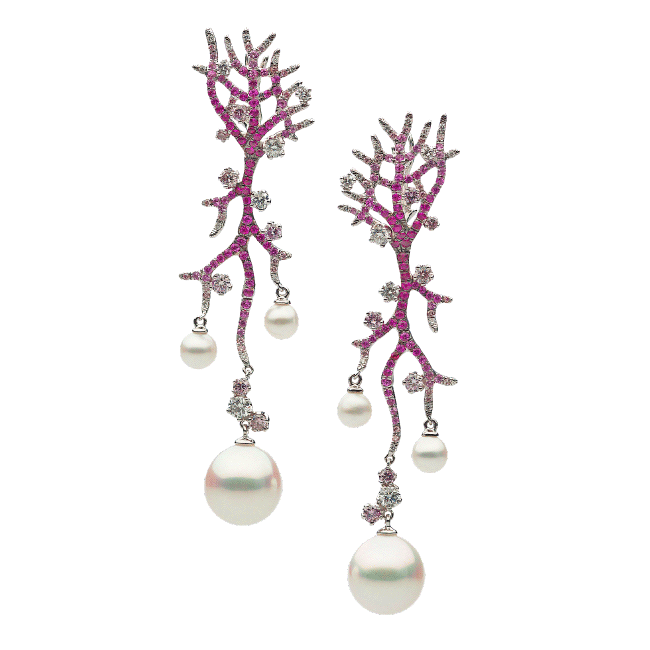 | 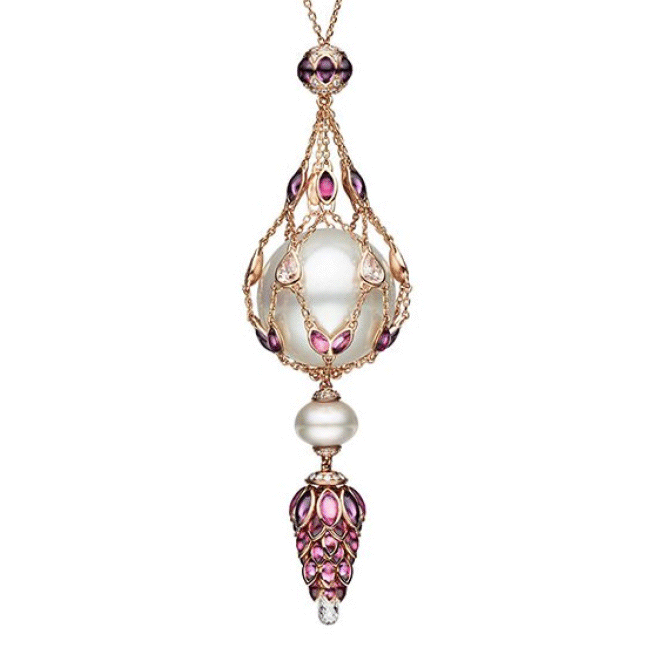 | 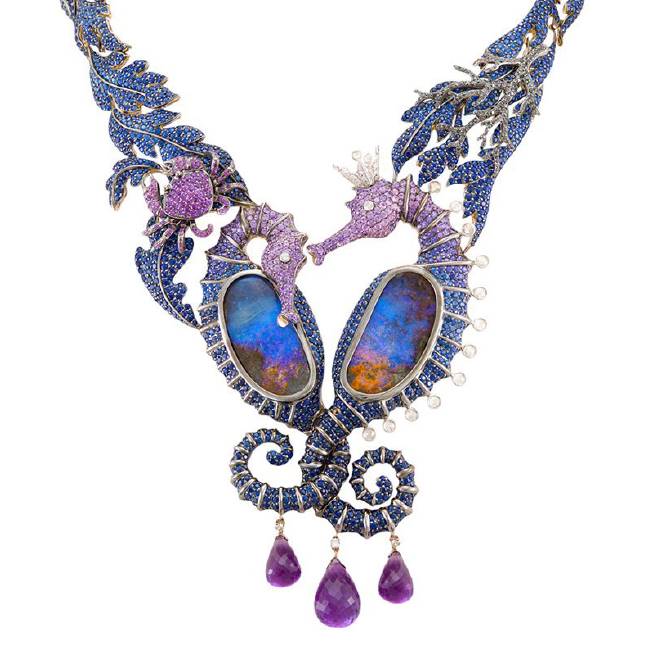 |
| Above: Autore | Above: Paspaley |
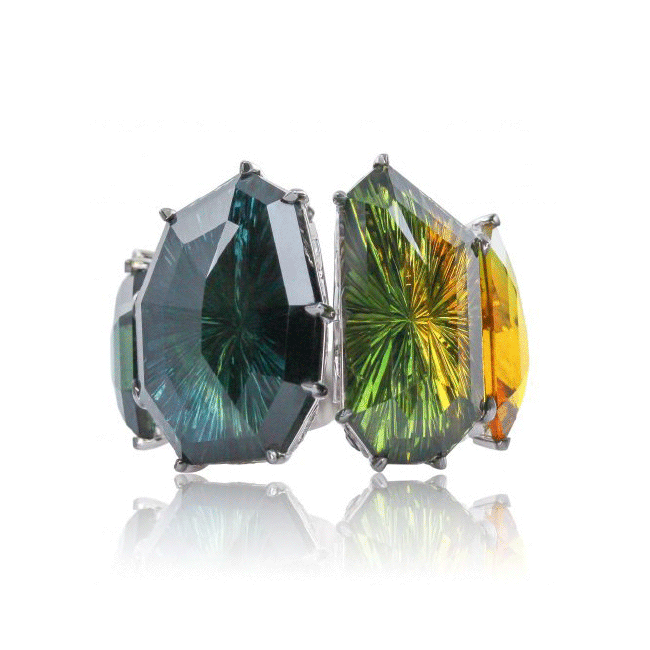 | 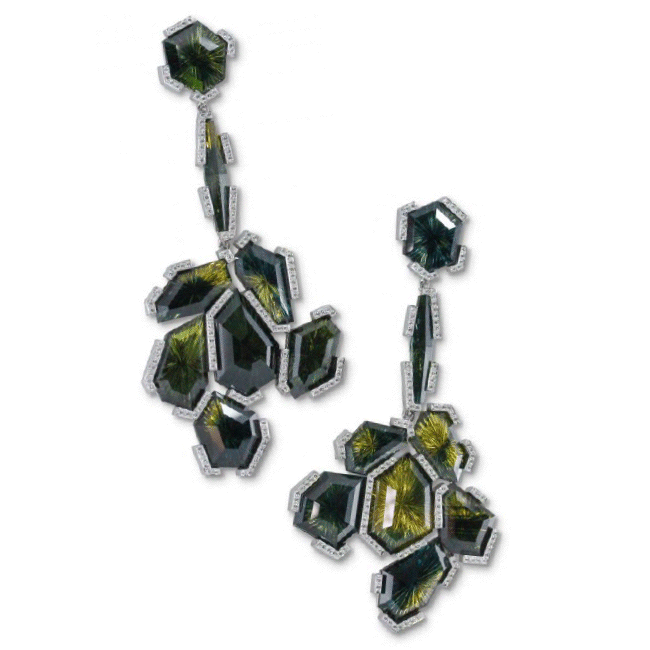 |
| Above and Right: Murazzo | | Above: Lydia Courteille |
Chrysoprase
Chrysoprase is one of the most prized examples of a chalcedony gemstone, valued for its vibrant green colour and rarity. It is created through the weathering of serpentine and consists mostly of silicon dioxide.
As the elements break down, the serpentine, nickel, silica and other iron oxides are dissolved out of stone and collected in crevices, cracks and clay. Although most green stones owe their colour to chromium or vanadium, chrysoprase derives its colour from the presence of disseminated particles of hydrated nickel silicate and ranges in colour from apple green to a deep rich green.
It is usually translucent but unlike many non-transparent members of the quartz family the colour of chrysoprase, rather than their patterns or markings, makes it more desirable and valuable.
Due to its bright, even colour and texture, chrysoprase is often cut into cabochons, beads and a base for intricate carvings.
It is popularly used for intaglios and cameos, dating back to Greek and Roman times and used lavishly throughout Europe until the middle of the last century, when it became rare and more expensive.
Chrysoprase is primarily sourced from central Queensland in Australia and due to its abundance, is often referred to as “Australian jade”.
The best quality chrysoprase is produced from the Marlborough deposits near Rockhampton in central Queensland. The gemstones are also found in numerous locations in Western Australia such as the Marshall Pool, Yerilla, Yundamindra, Jamieson and Wingellina deposits.
The name ‘chrysoprase’ is derived from the Greek word “chryos”, meaning golden and “prason”, meaning leek or green.
The gemstone was given its name in the 18th century when a vein was discovered in Silesia – which is now Poland - at the time of Frederick the Great of Prussia, who held a particular fondness for the gem.
Among his favourites was a walking stick adorned with a knob of chrysoprase and a ring set with a large chrysoprase surrounded by 15 diamonds. The gemstone was believed to bring supernatural and spiritual protection, prevent depression, promote equilibrium and increase fertility.
Due to its excellent durability, chrysoprase is widely used in jewellery-making. It is rated 6.5 to 7 on the Mohs hardness scale, making it resilient and suited for jewellery and carving.
It is easily handled for creative and artistic designs as it takes on a fine polish. The toughness of the gemstone makes it a very forgiving stone and allows for carvings and fine workmanship that brings out the brilliance when reflecting ambient light.
Chrysoprase jewellery can be worn daily and maintained using an ultrasonic jewellery cleaner or with warm, soapy water and a soft brush. The gemstone’s vibrant hue can fade in the sunlight over time due to dehydration, which deprives the gemstone of its colouring agent. The gemstone can lose its lustre when it dries but can be restored by soaking in water.
Zircon
Zircon is considered to be the oldest mineral on earth and Australia has the largest and oldest deposits, dating back more than 4.4 billion years.
The most prominent source of Australian zircon is the Mud Tank Zircon Field in the Harts Range area situated some 1,220 kilometres south to southeast of Darwin in the Northern Territory.
First explored in the 1940s, the area is well-known amongst fossickers and speculators for its top-quality zircon, specifically from two locations the Zircon Hill and Specimen Hill. Waterworn zircon crystals occur mostly in the low-lying areas between the two hills.
Prized for its diamond-like lustre, intense fire, brilliance and strong double refraction, zircon sets itself apart from the rest of the gem-quality minerals.
The zircons of Australia display beautiful earthy tones of sherry, cinnamon, cognac, pinks, plums, yellow, and orange, as well as gemstones that are partially coloured and colourless.
Zircon may occur as small, doubly terminated crystals or chips, and larger specimens may show well-developed crystal faces and are often found intermixed with sapphire in deposits associated with tertiary volcanic deposits in Tasmania and northern Queensland.
The zircon gemfields of northern New South Wales and central Queensland produce gemstones ranging from colourless to champagne and orange-red.
Australian zircons are often heat-treated to lighten, or to make them colourless, and are prized for their lustre, brilliance, colour intensity, and strong double refraction. Golden brown gemstones can be similar to citrine or topaz.
Zircon contains traces of uranium, which allows for self-irradiating and the changing of properties. It is classified into three types – high, intermediate and low. The gemstones are rated 7 to 7.5 on the Mohs hardness scale.
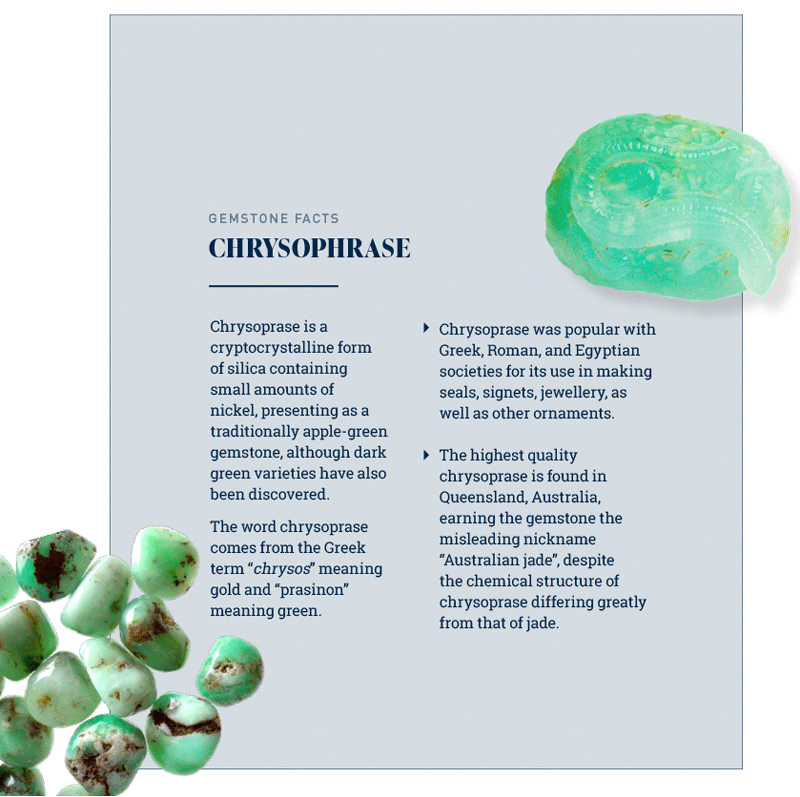 | 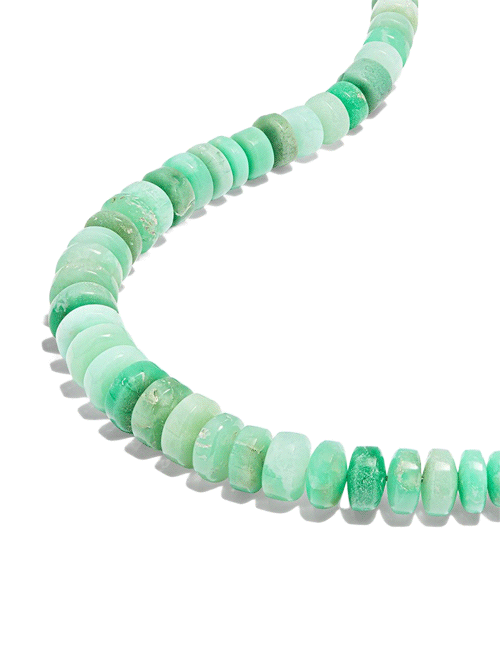
Jacquie Aiche |
| | |
Read eMag